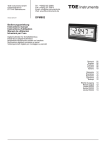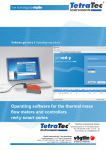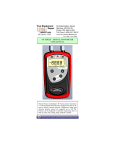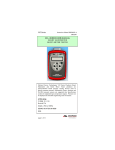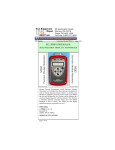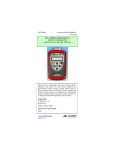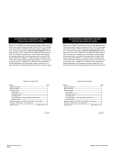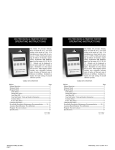Download 350 HANDHELD MANOMETER OPERATING INSTRUCTIONS
Transcript
File No. 350:440-2 350 HANDHELD MANOMETER OPERATING INSTRUCTIONS Meriam’s 350 Handheld Smart Manometer is a microprocessor based pressure sensing device that can be used to directly measure pressure. Differential pressure units (clean dry gases only) can also measure flow when used with a square root type primary flow element. Models are available to measure gauge, absolute, differential and vacuum pressure in ranges from 20” w.c. to 2000 PSIG. Pressure can be displayed in a variety of engineering units. TABLE OF CONTENTS Subject Page Keypad functions --------------------------------------------------- 2 Pressure zeroing the manometer ----------------------------------- 3 Program mode-------------------------------------------------------- 4 Units select ----------------------------------------------------------- 4 User unit select ------------------------------------------------------ 5 Flow unit select ------------------------------------------------------ 7 Damp rate select ---------------------------------------------------- 8 Auto shut off --------------------------------------------------------- 9 User info select -----------------------------------------------------10 Contrast select ------------------------------------------------------12 Specifications -------------------------------------------------------13 Resolution -----------------------------------------------------------14 Changing the battery -----------------------------------------------15 Recalibration --------------------------------------------------------15 KEYPAD FUNCTIONS ON/OFF & BACKSPACE KEY Turns the manometer on into the Measure Mode and then turns the unit off from the Measure Mode. Also serves as a backspace key when editing in the Program Mode. The backspace function takes the user out of a programmable register without changing the previous setting. Pressing this key repeatedly will return the user to the Measure Mode and then shut off the manometer. MIN/MAX & UP ARROW KEY In the Measure Mode activates the Min/Max function of the manometer. When activated the the minimum value is displayed on the upper left of the display and the maximum value on the upper right. Min/Max values on the display are updated every 0.1 seconds. This key also deactivates this function. Up arrow key is used to scroll through the programmable registers when the unit is in the Program Mode. Once a programmable register is selected the up arrow can be used to edit that register. HOLD & DOWN ARROW KEY In the Measure Mode activates and deactivates the display Hold function. This is designed to freeze a value being displayed. If the MIN/MAX function is activated, those values are also frozen. With HOLD activated, the letter “H” appears in the lower left of the display. Down arrow function is used to scroll through programmable registers with the unit in the Program Mode. Once a programmable register is selected the down arrow can be used to edit that register. PRGM & ENTER KEY Puts the manometer into the Program Mode from the Measure Mode. When in the Program Mode, pressing this key selects the programmable register to be edited. After the register has been edited, pressing the PRGM key enters the new setting into the manometer’s non-volatile memory. This key also acts as a forward space key when editing user input such as the header name. 2 PRESSURE ZEROING THE MANOMETER Prior to making a pressure measurement, the 350 Smart Manometer should be zeroed for pressure. This will eliminate any zero drift that has occurred since the manometer was last used. To zero the manometer, starting with the unit turned off, follow this key stroke sequence: Keystroke Display 1. Press ON/OFF button. The display briefly shows the header name and full scale range of the unit in the last engineering units selected. The manometer then goes into the Measure Mode where the applied pressure and engineering unit of measure are displayed. Display should read close to zero. (See note below) 2. Turn off pressure sources and vent pressure ports to atmosphere. Top line of display reads “ZERO IN PROGRESS” while bottom line counts down from 9. Zeroing is complete when unit returns to Measure Mode. 3. Press MIN/MAX and HOLD keys at the same time. (See figure 1) Note: All Models and ranges can be zeroed only if the new Zero is within ± 5% of the original factory calibration zero. If outside this limit a “ZERO ERROR” message appears and the manometer will not zero. Figure 1. 3 PROGRAM MODE The Program Mode is used to configure the manometer for Measure Mode operation. The configurable registers that are found in the Program Mode are Units Select, Damp Rate Select, User Info Select, Contrast Select and Exit. The manometer can be put into the Program Mode at any time during Measure Mode operation by pressing the PRGM key. The top line of the display will read “PROGRAM MODE”. The bottom line will read “UNITS SELECT”. Press the up or down arrow keys to scroll through the Program Mode to the desired register. UNITS SELECT The standard engineering units available on the Smart Manometer are: 1. PSI 2. Inches of Water at 20° Celsius 3. Inches of Water at 60° Fahrenheit 4. Inches of Water at 4° Celsius 5. Kg/ cm2 6. Kilopascals 7. Millibars 8. Bars 9. Centimeters of Water at 20° Celsius 10.Inches of Mercury at 0° Celsius 11.Millimeters of Mercury at 0° Celsius 12.User unit select. (see page 5) 13.Flow units. (see page 7) To change engineering unit of measure the manometer should be “ON” and in the Measure Mode. Then follow the following steps: Keystroke Display 1. Press PRGM key. Top line reads “PROGRAM MODE” and bottom line reads “UNITS SELECT”. 2. Press PRGM key Top line reads “UNITS SELECT” and bottom shows current engineering units 4 3. Press up or down arrow key until desired engineering unit is displayed. Engineering units on bottom line of display change. 4. Press the PRGM key to select engineering unit. Top line reads “PROGRAM MODE” and bottom line reads “UNITS SELECT”. Bottom line reads “EXIT” 5. Press the down arrow key. Display returns to Measure Mode in new engineering units. 6. Press PRGM key. USER UNIT SELECT Engineering units not included in the standard selection can be programmed into the manometer using the Units Select register in the Program Mode. This is done by an internal microprocessor that multiplies the applied pressure in the base factory calibration units by the value in the user unit register. For example, 1 PSI equals 2.30894 Feet of Water at 60° F. A 20 PSI manometer can be programmed to read out in Feet of Water using the following steps: Keystroke Display 1. Follow steps 1-3 in “Units Select” (pg. 4) until “USER UNIT SELECT” is displayed. Reads “USER UNIT SELECT” on the bottom line. 2. Press PRGM key. (see Note: on pg. 7) Reads “VALUE=” on the top line and “CHANGE?: YES” on the bottom line. 3. To change the value press the PRGM key. Top line reads “USER UNIT VALUE”. 5 4. Press the up arrow key until the first digit reads “2”. Top line reads “USER UNIT VALUE” Bottom line reads “20000000”. (new units) 5. Press the right arrow key to enter this value and advance the cursor to the next digit. Cursor flashes to the right of “2”. (Numbers 0-9, decimal point or a blank space can be displayed.) 6. Repeat steps 4 and 5 until the bottom line of the display reads 2.30894. Bottom line reads “2.30894” Last digit “4” is blinking. 7. If an error is made use the back space key to move the cursor back to the incorrect digit. Press the up or down arrow keys to display the correct value. 8. Press the PRGM key Top line reads “VALUE =”. until the display changes. Bottom line reads (see Note: on pg. 7) “CHANGE?: YES”. 9. Press the PRGM key. Top line reads “USER UNIT NAME”. 10.Follow steps 4-6 above to enter “FT H2O” Bottom line reads “FT H2O”. (A-Z, 0-9, decimal point or a blank space can be displayed.) 11. Press PRGM key. Top Line reads “PROGRAM MODE” and bottom line reads “UNITS SELECT”. Bottom line reads “EXIT”. 12. Press down arrow key. Manometer returns to Measure Mode. Display shows “FT H2O”. 13. Press PRGM key. 6 Note: If at steps 2 and 8 the “VALUE =” is the desired value or description, press the up or down key. This will toggle the bottom line from the default “CHANGE?: YES” to “CHANGE?: NO”. Follow steps 11-13 on page 6 to return to the Measure Mode. FLOW UNIT SELECT Differential Pressure Smart Manometers can be programmed to read out in flow measurement units such as CFM or Lit/min. This use is limited to clean, dry, noncorrosive gases. The primary element has to be a differential pressure producing, square root type device such as a pitot tube, orifice plate or venturi. The flow constant and flow units description are programmed into the manometer using the same keystrokes used in User Unit Select programming. At step 1 choose Flow Unit Select instead of User Unit Select. The formula used in calculating the flow rate is: ½ Fc = Q ÷ DP Where Q = Flow rate Fc = Flow constant DP = Differential Pressure (in. H2O at 20°C) Example: If the DP is 25 in. H2O when the flow rate is 10,000 SCFM, the Flow constant equals 2,000. 7 DAMP RATE SELECT Adjustable damping is available to steady the display when measuring pulsating pressure or flow. The Smart Manometer has a range of damping rates of 0.1, 0.2, 0.5, 1, 2, 5, 10, and 25 seconds. Damping is done by averaging new data from the pressure sensor against previously collected data. The microprocessor collects data from the sensor every 0.1 seconds. The display updates every 0.5 seconds, showing the current 0.1 second pressure reading. When set at 25 seconds, the display updates every 0.5 seconds with the average of the previous 25 seconds readings. Therefore, it takes up to 25 seconds from the time pressure is applied until the manometer displays the full scale applied pressure. Min/Max display updates every 0.1 seconds. To set the damp rate: Keystroke Display 1. Follow steps on page 4 to Top line reads “PROGRAM MODE” bottom line reads put the unit in Program “UNITS SELECT”. Mode. 2. Press the up key. arrow Bottom line reads “DAMP RATE SELECT”. 3. Press the PRGM key. Top line reads “DAMP RATE SELECT”. 4. Press the up or down arrow keys until the desired damp rate is displayed on bottom line. Bottom line shows damp rate in seconds. 5. Press the PRGM key. Top line reads “PROGRAM MODE” bottom line reads “UNITS SELECT”. 6. Press the down arrow key. Bottom line reads “EXIT”. 7. Press the PRGM key. Returns to Measure Mode. 8 AUTO SHUT-OFF Enabling the Auto Shut-Off feature allows the manometer to turn itself off after approximately ten minutes of keypad inactivity. Disabling this feature limits the manometer to being turned off by using the ON/OFF key only. Units are shipped from the factory with the Auto Shut-Off enabled. To configure the auto shut-off follow the steps below. Keystroke Display 1. Follow steps 1-7 on page 10. Top line reads “AUTO SHUT-OFF” bottom reads “ENTER TO SELECT”. 2. Press the PRGM key. Bottom line reads “ENABLED” or “DISABLED”. 3. Press the up or down arrow keys. Auto Shut-Off status on bottom line changes. 4. Press the PRGM key. Top line reads “HEADER NAME” bottom line shows header. 5. If Header needs to be edited follow steps 11-17 on pages 11. Changes Header and returns to Measure Mode. 6. If header is correct follow Returns to Measure Mode. steps 8-10 on page 11. 9 USER INFO SELECT The User Info Select register is designed to provide the user with information on the hardware and software in the manometer. This register stores information on the sensor’s serial number, software version, date of last calibration, Auto Shut-Off status and the instrument Start-Up Header. The Start Up Header appears whenever the manometer is turned on. Below the Header is the Full Scale of the manometer, in the last engineering units programmed. The factory setting of the header is “MERIAM INSTR.”. This can be edited to show a custom alpha-numeric string as required by the user. To configure the Unit Info Select register follow the keystrokes listed below. Keystroke Display 1. From the Measure Mode, press the PRGM key Top line reads “PROGRAM MODE”. Bottom line reads “UNITS SELECT” 2. Press the up two times. arrow key Bottom line changes to “USER INFO SELECT” 3. Press the PRGM key. Bottom line shows serial number. 4. Press the PRGM key. Software version number shown. 5. Press the PRGM key. Calibration Date shown. 6. Press the PRGM key. Top line reads “AUTO SHUT OFF” bottom line reads “ENTER TO SELECT” 7. Instructions for setting the AUTO SHUT-OFF are on page 9. Press up arrow key to proceed to editing the Header. Top line reads “HEADER NAME” bottom line reads “MERIAM INSTR.”. Cursor flashes at bottom left. 10 8. If header is correct press Top line reads “PROGRAM backspace key . If MODE”. Bottom reads editing is desired proceed “USER INFO SELECT” to step 11. 9. Press up arrow key two times. Bottom line reads “EXIT”. 10. Press the PRGM key. Returns to Measure Mode. 11. Press the up or down arrow keys to set correct alpha-numeric value. Displays a number between 0 and 9, a letter from A to Z, / or a blank space. 12. Press right arrow accept entry. Cursor advances one space to right. to 13. Repeat steps 11 and 12 until the desired Header is shown. 14. If an error is noted press the back arrow key until cursor is over the incorrect value. Follow step 11 to correct. Press the right arrow to advance the cursor without changing values. 14. When header is complete press the PRGM key to advance cursor to end of bottom line. Cursor flashes at bottom right. 15. Press the PRGM key. Top line reads “PROGRAM MODE” bottom reads “UNITS SELECT”. 16. Press down arrow key Bottom line reads “EXIT”. 17. Press the PRGM key. Returns to Measure Mode. 11 CONTRAST SELECT The Contrast Select register allows the user to adjust the character contrast of the LCD display to provide the best visibility for the ambient conditions. If during the contrast adjustment an error is made pressing the backspace key returns the display to the previous contrast setting. To adjust the contrast follow the keystrokes below: Keystroke Display 1. From the Measure Mode press the PRGM key. Top line reads “PROGRAM MODE” bottom reads “UNITS SELECT”. 2. Press the up arrow key three times. Bottom line reads “CONTRAST SELECT”. 3. Press the PRGM key. Top line reads “CONTRAST SELECT” bottom line shows a numerical value. 4. Press up or down arrow keys to increase or decrease the contrast value. A low number gives maximum contrast and a high number gives minimum contrast. LCD lightens or darkens depending on value set. 5. Press the PRGM key. Top line reads “PROGRAM MODE” bottom reads “UNITS SELECT”. 6. Press down arrow key. Bottom line reads “EXIT”. 7. Press the PRGM key. Returns to Measure Mode. 12 SPECIFICATIONS Type and Range: DN: Differential Non-Isolated 20“, 200”, 2000” H20 GI: Gauge Isolated 20 PSI, 200 PSI, 2000 PSI AI: Absolute Isolated 900, 2000 mm Hg Accuracy: 350 Test Gauge: ±0.05 % of Full Scale 351 Calibrator: ±0.025 % of Full Scale -5°C to 50°C ±0.05% of Full Scale -20°C to -5°C -DN0020 versions have only ±0.1 % of Full Scale Includes the combined effects of temperature, linearity, repeatability, hysteresis and resolution. NIST certification supplied with manometer. Temperature: Storage: -40° F to 140° F (-40° C to 60° C) Operating: -4° F to 122° F (-20° C to 50° C) Media Compatibility: Non-isolated sensors for use with clean, dry non-corrosive gases only. Isolated sensors for all fluids compatible with 316SS. Pressure Limits: 2 × range on GI and AI units. 2 × range on DN units when pressurized on high side only; 150 PSI (10.5 Kg/cm²) static when applied to both sides of sensor simultaneously. Connection: 1/8” female NPT, 316SS. AI and GI models have 1 pressure port only (P1). DN models have 2 pressure ports. P1 is the high pressure connection and P2, the low pressure connection. Power: 9 volt battery, lithium or alkaline, field replaceable. Lithium is recommended for operation below 32° F (0° C). Display: 5 significant digit LCD Enclosure: 14 oz. ABS plastic (6.5” × 3.6” × 2,25”) CSA units: Intrinsically safe for Class 1, Groups A, B, C, and D. 13 14 XX.XXX XX.XXX XX.XXX XX.XXX XX.XXX XX.XXX Kg/cm² inH20 4°C inH20 60°F inH20 20°C PSI XX.XXX Bar XX.XXX XX.XXX cm H20 KPa XX.XXX in. Hg mBar XX.XXX mm Hg 20” WC XXX.XX XXX.XX XXX.XX XXX.XX XXX.XX XXX.XX XXX.XX XXX.XX XXX.XX XXX.XX XXX.XX 200” WC XXXX.X XXXX.X XXXX.X XXXX.X XXXX.X XXXX.X XXXX.X XXXX.X XXXX.X XXXX.X XXXX.X 2000” WC XX.XXX XXX.XX XXX.XX XXX.XX XX.XXX XX.XXX XXX.XX XX.XXX XXX.XX XX.XXX XXX.XX 20 PSI RESOLUTION XXX.XX XXXX.X XXXX.X XXXX.X XXX.XX XXX.XX XXXX.X XXX.XX XXXX.X XXX.XX XXXX.X 200 PSI XXXX.X XXXXX XXXXX XXXXX XXXX.X XXXX.X XXXXX XXXX.X XXXXX XXXX.X XXXXX 2000 PSI XXX.XX XXXX.X XXXX.X XXXX.X XXX.XX XXX.XX XXXX.X XXX.XX XXXX.X XXX.XX XXXX.X 900mm Hg XXX.XX XXXX.X XXXX.X XXXX.X XXX.XX XXX.XX XXXX.X XXX.XX XXXX.X XXX.XX XXXX.X 2000mm Hg CHANGING THE BATTERY The manometer is powered by one 9 volt battery. When the output of the battery under load drops below 6.5 volts the display will alternate between “LOW POWER DETECT” and “REPLACE BATTERY”. To replace the battery locate the battery compartment in the bottom rear of the manometer. Push down on the small rectangular area in the battery cover. While pushing the cover down, slide the cover out the bottom of the unit. Pull the battery connector off the battery terminals. Plug the new battery into the connector and install in the compartment. Slide the battery cover on until the locking clip goes into the manometer housing and the channels on the bottom of the cover are locked in place. RECALIBRATION The Smart Manometer’s accuracy can be verified by using a ± 0.015% of reading deadweight tester. It is recommended that the manometer be checked at a minimum of four test points at 25%, 50%, 75% and 100% of the units range. A full ten point evaluation provides the most complete information on the manometers performance. Before performing the evaluation there are several corrections to the deadweight tester that may have to be made. 1. Use the User Unit Select option in Program Mode to match the Smart Manometer units to the deadweight tester units. Be sure to match the Smart Manometer temperature reference to the temperature reference of the deadweight tester (for in.H2O and Hg units only). 2. Correct the deadweight tester readings for ambient temperature if it is different from the reference temperature. The Smart Manometer does this automatically. 15 3. The local gravity at location where the evaluation is being performed must be corrected for on the deadweight tester. Standard gravity reference is 980.665 cm/sec/sec. This gravity occurs at 45° north latitude, at sea level. 4. Make sure there are no leaks in the system. The 200” and 2000” in.H2O Smart Manometers have a calibration reference of inches of water at 20°C. The 2000 mm Hg absolute manometer references mercury at 0°C. The 20, 200 and 2000 PSI manometers are calibrated in PSI and therefore do not have a reference temperature. The effects of local gravity on the Smart Manometer are corrected for by zeroing the manometer (see pg. 3) before the evaluation. This evaluation will confirm whether the manometer is or is not operating within its accuracy specification at the temperature that the evaluation was performed at only. This does not guarantee that the manometer is within it’s accuracy specification at other temperatures. If the manometer is outside of it’s accuracy limits, it must be returned to the factory for recalibration. The Smart Manometer cannot be recalibrated in the field. If recalibration is required, contact the Meriam Instrument representative in your area or call the factory at the numbers listed below for a Return Material Authorization (RMA) number. All Smart Manometers recalibrated at the factory are returned with certificates of NIST traceability. Manufacturer: Distributor: Meriam Process Technologies 10920 Madison Ave. Cleveland, OH 44102 USA Ph. (216) 281-1100 FAX (216) 281-0228 Tetra Tec Instruments GmbH Gewerbestrasse 8 71144 Steinenbronn Germany Tel.: 07157/5387-0 Fax: 07157/5387-10 16

















